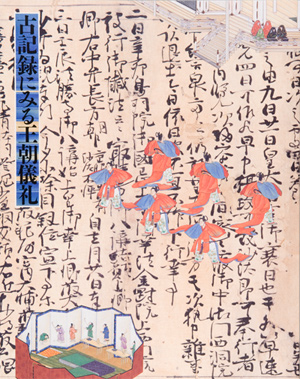| image | information |
|---|---|
 |
For the Heian Imperial Court officials, conducting a great variety of annual events, running from shihohai (the Emperor’s Worship of Dieties of the Four Directions) on New Year’s Day to tsuina (the Devil-Expelling Ceremony) on the last day of the year, as well as many other important rites and functions in full observance of the traditional customs and without any mishaps accounted for an overwhelming part of their daily activities. Every courtier, according to his rank, seriously studied his portion of each ceremonial processes and constantly checked on the available precedents so that he was always ready to perform his duties as required. Many courtiers, moreover, wrote down, in their diaries, what they had actually witnessed of the ceremonial events they had been part of so that they themselves or their posterities would benefit from them in the years to come. Such diaries, therefore, now form indispensable sources of information on the annual events and other important rites in the Heian Imperial Court. In the present exhibition, viewers will be presented with a glimpse of the manners, customs and etiquette of the Heian period through two late Heian period diaries - the Choshu Ki (or the Minamoto no Morotoki-kyo Ki) and the Heihyobu Ki (or the Taira no Nobunori Ki or the Hyohan Ki) - transcribed by a group of courtiers headed by Fujiwara no Sadaie, who brought Sarashina Nikki into the world and who himself wrote the Meigetsu Ki, and through the Kamakura period copies of the two Heian volumes on manners and customs - the Seikyu Ki (by Minamoto no Takaakira) and the Shinnin Benkan Sho (by Fujiwara no Toshinori). Viewers will also be presented with a look at the manners and customs of the Heian Imperial Court as recorded in the pictures accompanying the Kuji Roku, a record of the attempts in the Meiji period to study and restore, for the posterity, the then gradually disappearing traditional manners and customs handed down from the Heian period. We shall be more than fully gratified if the viewers will come to understand, through this exhibition, how carefully our ancestors tried to observe and preserve traditional manners and customs and how the important literature recording them have been handed down to this very day. |